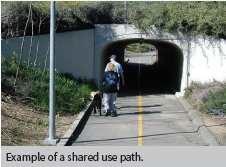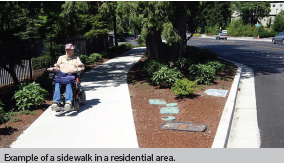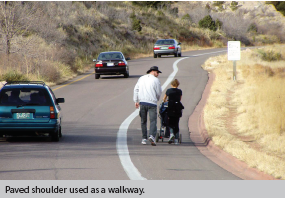U.S. Department of Transportation
Federal Highway Administration
1200 New Jersey Avenue, SE
Washington, DC 20590
202-366-4000
SAFETY BENEFITS:
Sidewalks
65-89%
Reduction in crashes involving pedestrians walking along roadways
Paved Shoulders
71%
Reduction in crashes involving pedestrians walking along roadways

Source: Desktop Reference for Crash Reduction Factors, FHWA-SA-08-011, Table 11.
A walkway is any type of defined space or pathway for use by a person traveling by foot or using a wheelchair. These may be pedestrian walkways, shared use paths, sidewalks, or roadway shoulders.1


With more than 5,000 pedestrian fatalities and 70,000 pedestrian injuries occurring in roadway crashes annually, it is important for transportation agencies to improve conditions and safety for pedestrians and to integrate walkways more fully into the transportation system.2
Well-designed pedestrian walkways, shared use paths, and sidewalks improve the safety and mobility of pedestrians. In some rural or suburban areas, where these types of walkways are not feasible, roadway shoulders provide an area for pedestrians to walk next to the roadway.
Transportation agencies should work towards incorporating pedestrian facilities into all roadway projects unless exceptional circumstances exist. It is important to provide and maintain accessible walkways along both sides of the road in urban areas, particularly near school zones and transit locations, and where there is pedestrian activity. Walkable shoulders should also be considered along both sides of rural highways routinely used by pedestrians.
1 FHWA defines a pedestrian walkway as a continuous way designated for pedestrians and separated from motor vehicle traffic by a space or barrier. By contrast, sidewalks are walkways that are paved and separated from the street, generally by a curb and gutter.
2 National Highway Traffic Safety Administration, Traffic Safety Facts - 2015 Data - Pedestrians. Report DOT HS 812 375, (Washington, DC: 2017).

